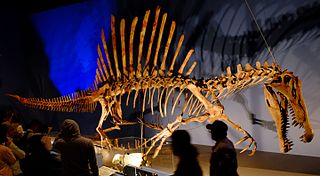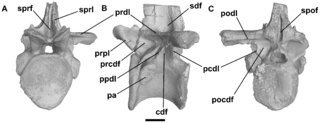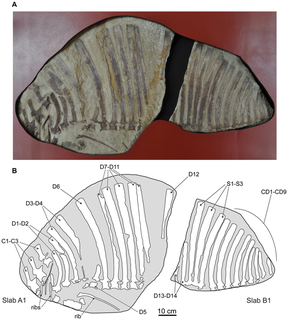
Fish anatomy is the study of the form or morphology of fishes. It can be contrasted with fish physiology, which is the study of how the component parts of fish function together in the living fish. In practice, fish anatomy and fish physiology complement each other, the former dealing with the structure of a fish, its organs or component parts and how they are put together, such as might be observed on the dissecting table or under the microscope, and the latter dealing with how those components function together in living fish.

Spinosaurus is a genus of theropod dinosaur that lived in what now is North Africa, during the upper Albian to upper Turonian stages of the Cretaceous period, about 112 to 93.5 million years ago. This genus was known first from Egyptian remains discovered in 1912 and described by German paleontologist Ernst Stromer in 1915. The original remains were destroyed in World War II, but additional material has come to light in the early 21st century. It is unclear whether one or two species are represented in the fossils reported in the scientific literature. The best known species is S. aegyptiacus from Egypt, although a potential second species, S. maroccanus, has been recovered from Morocco.

Ouranosaurus is a genus of herbivorous iguanodont dinosaur that lived during the early Cretaceous at some point between 125 and 112 million years ago, in what is now Africa. Ouranosaurus measured about 7 to 8.3 metres long. Two rather complete fossils were found in the Elrhaz Formation, Gadoufaoua deposits, Agadez, Niger, in 1965 and 1972. The animal was named in 1976 by French paleontologist Philippe Taquet; the type species being Ouranosaurus nigeriensis.

Edaphosaurus is a genus of extinct edaphosaurid synapsid that lived in what is now North America and Europe around 300 to 280 million years ago, during the late Carboniferous to early Permian periods. The American paleontologist Edward Drinker Cope first described Edaphosaurus in 1882, naming it for the "dental pavement" on both the upper and lower jaws, from the Greek edaphos/εδαφος and σαυρος/sauros ("lizard").

Stethacanthus is an extinct genus of shark-like Holocephalian which lived from the Late Devonian to Early Carboniferous epoch, dying out around 323.2 million years ago. Fossils have been found in Asia, Europe and North America.

Hypselorhachis is a genus of extinct reptile, possibly a ctenosauriscid archosaur related to Ctenosauriscus. It lived during the Triassic Period. It is currently known only from a single vertebra found from the Middle Triassic Manda Beds in Tanzania. The vertebra is preserved in reasonably good condition, as although the tall neural spine is chipped in several places it is not broken despite being quite slender, only around 20 mm thick transversely.
Ichthyology uses several terms that are unique to the science.

Sphenacodon is an extinct genus of synapsid that lived from about 300 to about 280 million years ago (Ma) during the Late Carboniferous and Early Permian periods. Like the closely related Dimetrodon, Sphenacodon was a carnivorous member of the Eupelycosauria family Sphenacodontidae. However, Sphenacodon had a low crest along its back, formed from blade-like bones on its vertebrae instead of the tall dorsal sail found in Dimetrodon. Fossils of Sphenacodon are known from New Mexico and the Utah-Arizona border region in North America.

Secodontosaurus is an extinct genus of "pelycosaur" synapsids that lived from between about 285 to 272 million years ago during the Early Permian. Like the well known Dimetrodon, Secodontosaurus is a carnivorous member of the Eupelycosauria family Sphenacodontidae and has a similar tall dorsal sail. However, its skull is long, low, and narrow, with slender jaws that have teeth that are very similar in size and shape—unlike the shorter, deep skull of Dimetrodon, which has large, prominent canine-like teeth in front and smaller slicing teeth further back in its jaws. Its unusual long, narrow jaws suggest that Secodontosaurus may have been specialized for catching fish or for hunting prey that lived or hid in burrows or crevices. Although no complete skeletons are currently known, Secodontosaurus likely ranged from about 2 to 2.7 metres in length, weighing up to 110 kilograms (250 lb).

Synodontis nigrita, known as the false upside down catfish, is a species of upside-down catfish that occurs widely in northern Africa. It was first described by French zoologist Achille Valenciennes in 1840. The type specimen is in the Muséum National d' Histoire Naturelle de Paris.

Synodontis petricola, known as the cuckoo catfish, or the pygmy leopard catfish, is a species of upside-down catfish endemic to Burundi, Zambia, the Democratic Republic of the Congo, and Tanzania where it is only known from Lake Tanganyika. It was first described by Belgian ichthyologist Hubert Matthes in 1959. The species name "petricola" is derived from a combination of the Latin petra, meaning stone or rock, and the Latin cola, meaning inhabitant. This refers to the rocky environment where this species is found.

Ctenosauriscus is an extinct genus of sail-backed poposauroid archosaur from Early Triassic deposits of Lower Saxony in northern Germany. It gives its name to the family Ctenosauriscidae, which includes other sail-backed poposauroids such as Arizonasaurus. Fossils have been found in latest Olenekian deposits around 247.5-247.2 million years old, making it one of the first known archosaurs.

Synodontis caudovittatus, known as the white-finned synodontis, is a species of upside-down catfish that is native to the Nile basin of Ethiopia, South Sudan, and Sudan. It was first described by British-Belgian zoologist George Albert Boulenger in 1901, from specimens collected in the White Nile, at the mouth of Lake No in South Sudan. The species name caudovittatus comes from the Latin word cauda, meaning "tail", and the Latin word vitta, meaning "stripe" and refers to the coloration of the tailfin.

Synodontis macrostigma, known as the largespot squeaker, is a species of upside-down catfish that is native to Angola, Botswana, Namibia, South Africa and Zambia where it is found in the Cunene, Okavango, upper Zambezi and Kafue River systems. It was first described by British-Belgian zoologist George Albert Boulenger in 1911, from specimens collected in the Okovango River, Botswana, by R. B. Woosnam. The species name macrostigma is derived from the Greek word makros, meaning "large", and the Greek word stigma, meaning "mark" or "spot" and refers to the large spots on the sides of the fish.

Synodontis nigromaculatus, known as the spotted squeaker, the blackspotted squeaker, or the speckled squeaker, is a species of upside-down catfish that is found widely in southern Africa. It has been identified in Angola, Botswana, the Democratic Republic of the Congo, Mozambique, Namibia, South Africa, Zambia, and Zimbabwe. It was first described by British-Belgian zoologist George Albert Boulenger in 1905, from specimens collected in Lake Bangweulu in Zambia. The species name nigromaculatus is derived from the Latin word nigro, meaning "black", and the Latin word maculatus, meaning "spotted", which refers to the dark spots on this species.
Synodontis lucipinnis is a species of upside-down catfish endemic to Zambia, where it is only known from the Musende Rocks area (Mpulungu) of Lake Tanganyika. It was first described by Jeremy John Wright and Lawrence M. Page in 2006. The species name "lucipinnis" is derived from a combination of the Latin luci, meaning bright or clear, and the Latin pinnis, meaning fin. This refers to the light coloration in a patch on the base of the fins of this species.
Xilousuchus is an extinct genus of poposauroid from lower Triassic deposits of Fugu County of northeastern Shanxi Province, China. It is known from the holotype, IVPP V 6026, a single well-preserved partial skeleton including the skull. It was found from the Heshanggou Formation of the Ordos Basin, Hazhen commune. It was first named by Xiao-Chun Wu in 1981 and the type species is Xilousuchus sapingensis. Wu (1981) referred Xilousuchus to the Proterosuchia. Gower and Sennikov (1996) found it to be an erythrosuchian based strictly on the braincase. A more detailed re-description of the genus was provided by Nesbitt et al. (2010) and found poposauroid affinities. In his massive revision of archosaurs which included a large cladistic analysis, Sterling J. Nesbitt (2011) found Xilousuchus to be a poposauroid which is most closely related to Arizonasaurus. Xilousuchus is the oldest archosaur to date, although Ctenosauriscus and Vytshegdosuchus might be even older by less than one million year. Since Xilousuchus is a suchian archosaur, its early age suggests that most of the major groups of archosaurs developed by the Early Triassic, soon after the appearance of the first archosaur.

Ichthyovenator is a genus of spinosaurid theropod dinosaur that lived during the Early Cretaceous of what is now Laos, likely from the Aptian stage. Ichthyovenator is known from fossils collected in the Grès supérieurs Formation. Like other members of its family, it had elongated neural spines forming a sail on its back, although Ichthyovenator's was unusual due to its particular wave-like curvature and being split in two over the hips. Ichthyovenator was initially thought to belong to the Baryonychinae subfamily, but more recent analyses place it in the Spinosaurinae.
















